公開日 2021年11月12日
Mt. Oyama Pilgrimage: The Commoners’ Journey of Faith and Leisure
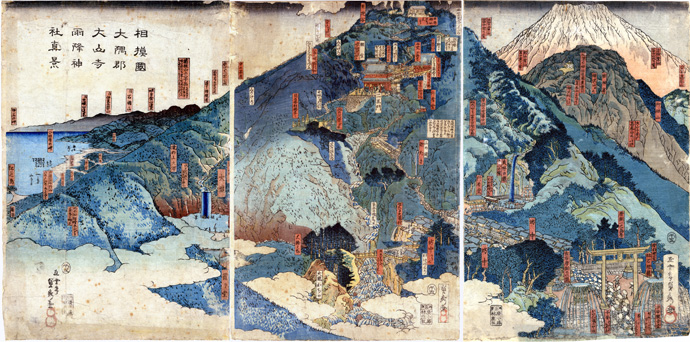
Mt.Oyama has been worshipped long time.In the Nara period, Ryozen-ji (present Hojo-bo, commonly called Hinata Yakushi), Sekiun-ji, and Oyama-dera Buddhist temples were established.“Engishiki Jinmyo-cho”, the list of Shinto shrines on the statute book which was compiled in the Heian period, includes Afuri-jinja, Hibita-jinja, and Takabeya-jinja shrines on and around Mt. Oyama.Thus, Oyama grew to be a sacred mountain gradually. Called Rain-falling Mountain, it also attracted a great number of ordinary people who came to pray for rain, a rich harvest of grains, and business success. However, divine grace was not the sole thing that the pilgrims wished for.
1. Who are the Oshi Priests that Attracted Pilgrims to Oyama?
In 1590 during the late Civil War period, shugenja priests who practiced ascetics on Mt. Oyama were armed and fought together with the warriors of Hojo in the war in which the Hojo clan was eventually defeated by Toyotomi Hideyoshi’s army. Then Tokugawa Ieyasu reformed Oyama drastically to make it a pure religious place.Thinking it would be risky to have militant priests’ forces on the outskirts of Edo, he expelled both shugenja priests and married priests from the mountain.He supported the temple financially by donating land at the same time.
Not giving up their faith, the priests who were ordered by Ieyasu to get away from Mt. Oyama stayed halfway down the mountain and began to run inns which had altars in order to survive.They were called oshi priests. Besides running inns or souvenir shops, they traveled over 100 days visiting their parishioners across the Kanto region to distribute talismans and to collect donations, while they steadily propagated the miraculous efficacy of Fudo Myo-o enshrined at Oyama-dera and Sekison Daigongen enshrined at the summit of Mt. Oyama.
2. Oyama Pilgrimage both for Faith and for Pleasure
(1) Organizing Oyama-ko pilgrimages as well as excursions for ordinary people
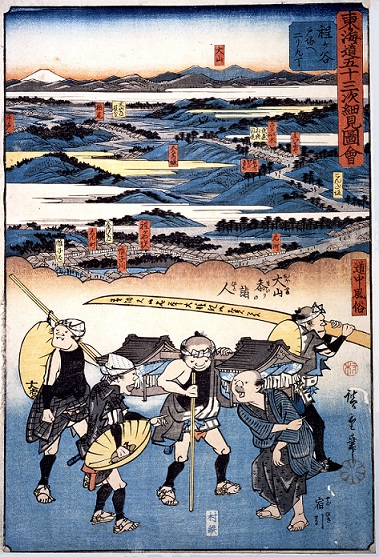
The mystical figure of Mt. Oyama can be seen from all over the Kanto region.Especially from Edo, it could be viewed together with Mt. Fuji. A pilgrimage to Mt. Fuji was popular in the Edo period.However, it was a long journey taking at least seven days and also it required pilgrims to show their ID cards when they passed the Hakone checkpoint.On the other hand, there was no checkpoint to pass on the way to Mt. Oyama.It was a short trip taking three or four days, even when they made a detour to do the sights of Enoshima or Kanazawa Hakkei on the way back home.
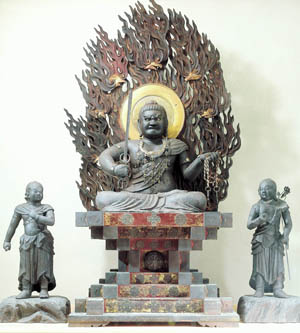
However short the distance from Edo to Mt. Oyama was, it was not easy at all for ordinary people to go there, because they had to save money enough to pay all necessary expenses on their own.Therefore, they organized Oyama pilgrimage groups of the same trades, like today’s neighborhood associations, and made up a system that they deposited money to share so that they could take turns in traveling to Oyama.Since oshi priests worked hard to spread the belief, they got more and more followers not only in the Kanto region, but also in Shizuoka, Yamanashi, Nagano, Niigata, and Fukushima.They had over a million households under their care at the height of their activity.In this way, taking advantage of its convenient location from Edo and historical resources, Oyama became well-known not only as a wonder-working mountain, but also as an affordable destination for faith and pleasure which does not require ascetic practices or religious precepts
(2) “Let’s go to Oyama, now!” carrying Osamedachi swords on their shoulders
The roads to Oyama from every area of the Kanto region are called Oyama-michi.Pilgrims walked merrily towards Mt. Oyama, which was seen in the distance with Mt. Fuji behind, following the stone-made signposts set up here and there, while viewing Sagami Bay on their left.The huge wooden swords they carried on the shoulders from Edo were called osamedachi , which were to be offered to Oyama-dera Temple.The origin of this tradition is attributed to Minamoto no Yoritomo, who established Japan’s first military government in the late 12th century.He offered his own sword to Oyama, praying for his everlasting military success.The practice of ordinary people’s offering wooden swords couldn’t be seen at any other religious establishment in Japan.People of all trades liked to visit Oyama.
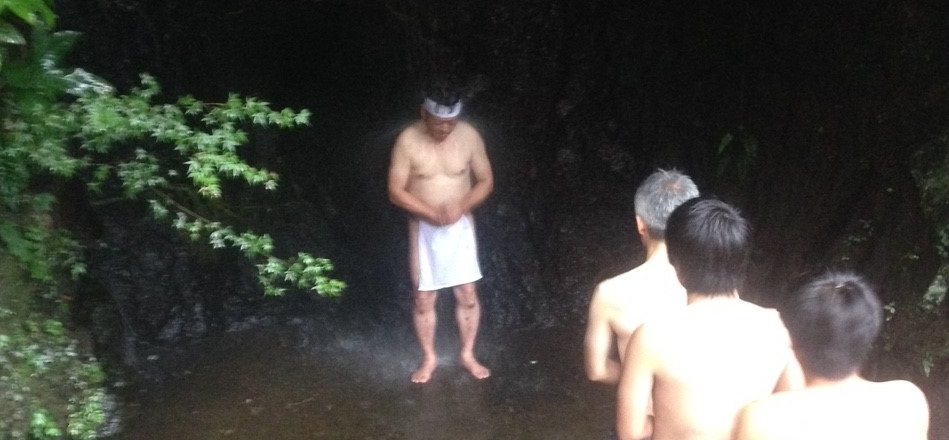
Among all, there were many organized ko groups of tobi construction workers, carpenters and firefighters.They had a special attachment toward Oyama, because they worked on the high scaffolding or buildings which commanded a view of Mt. Oyama in the distance.They came in order to get divine help of Mt. Oyama, which is also called Rain-falling Mountain, and of Sekison (stone deity) Daigongen enshrined on the summit, for their trades were associated with water and stone.Wooden swords to dedicate became larger and larger in size, as they competed against each other for showing off.Somebody offered a 7-meter-long sword in the Edo period.Some people gambled away their money and traveled to Oyama escaping debt collectors.Offered wooden swords conveyed ordinary people’s wishes for a plentiful harvest of grains, business prosperity, and better luck in gambling, just like warriors’ prayers for military success.
(3) Oyama Pilgrimage depicted in Kabuki dramas and Ukiyo-e woodblock prints
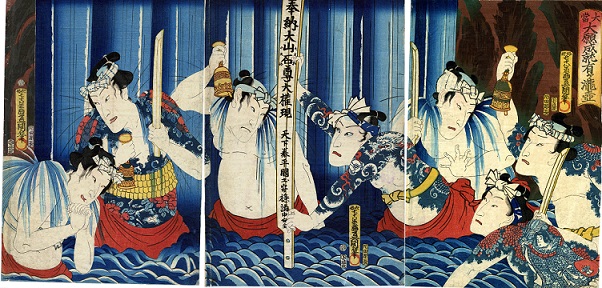
Pilgrims performed ablutions under the waterfall halfway up the mountain before proceeding to the temple.The waterfall for ablutions served as a special stage for high-spirited construction workers to show off their tattooed bodies to others.Many people got interested in the Oyama pilgrimage hearing a story like this.The Oyama pilgrimage was depicted in a kabuki play, joruri dramatic narrative, rakugo comic story, and senryu poems.Ukiyo-e woodblock prints further enhanced people’s interest in Oyama.About 200,000 people visited Oyama annually, when the population of Edo was one million.They came to Oyama, inspired by ukiyo-e wood-block prints depicting people on the Oyama pilgrimage, or a kabuki actor, in the role of a construction worker with a tattoo on his back, performing his ablutions at a waterfall holding a gigantic wooden sword.
(4) Hospitality at Shukubo inns and flourishing business at the foot of Mt. Oyama
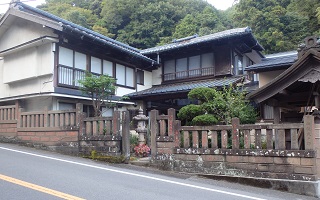
Shukubo inns welcome pilgrims as if they were their family members.Ko groups’ names and their addresses are inscribed on the stone fences surrounding the inn.Outside the entrance hall are stone monuments to the memory of the ko groups’ visits, water basins they donated, wooden boards with the inscription of the ko names, and long strips of cloth with the ko names resist-dyed.All of these prove how close the ties between the shukubo inns and ko groups were.The oshi priests who ran shukubo took good care of their ko members, guiding them to the temple and shrine as well as providing them with accommodations and meals.Oshi prayed before his shukubo’s altar to the spirits invoked from Afuri-jinja Shrine for the ko members’ safe climbing.
Tofu cuisine, which has become the representative dish in Oyama now, was originally produced using local water and the soybeans donated by ko members who came from various areas.It was served to them in their own bowls which they deposited with their shukubo inns.Oyama koma tops produced by local woodworkers were purchased by pilgrims as souvenirs to bring back home.Everybody loved tops, for spinning a top suggested a good business in which money could spin (circulate) well.Oshi priests also brought tops as gifts when they visited their ko members.Thanks to the flourishing Oyama pilgrimage, those who did business at the foot of Mt. Oyama became very busy, not only keeping stores for pilgrims, but also supplying futon bedding, slippers, household goods, sake, and foodstuffs to shukubo inns.
3.People’s Faith and Spiritual Charms Remaining up to the Present
The Oyama pilgrimage has continued to the present by the efforts of sendoshi (who was called oshi here before the religious reform to separate Shinto from Buddhism in the Meiji period).Even now we can see ko members dressed in white guided by their sendoshi, and various religious rituals which have been conducted over the ages.
Shukubo inns, restaurants, and gift shops lining the approach to the temple and shrine produce a nostalgic atmosphere.Visitors can enjoy tofu cuisine which was originally a vegetarian diet, and special dishes with local foodstuffs like boar meat and mountain vegetables.
Visiting historical sites left in a rich, natural environment which still remains in the suburbs of the capital city and getting a panoramic view from the summit, you will feel fulfilled in having the same sentiments that our predecessors who adored Mt. Oyama might have had in the past.


